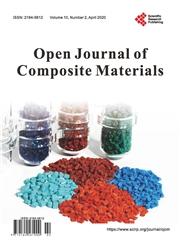Nylon/Porphyrin/Graphene Oxide Fiber Ternary Composite, Synthesis and Characterization
引用次数: 15
Abstract
This research was based on the manufacture of new composite materials that offer technological possibilities in the development of new devices with greater efficiency. Electrospinning was used to form nylon 66/-tetra-(para-aminophenyl) porphyrin (H2T(p-NH2)PP)/graphene oxide (GO) composite film. Graphene oxide coatings were obtained from graphite, through mechanical exfoliation followed by calcination and ultrasonic agitation in an oxidant solution. These samples were characterized under SEM, FTIR, Raman spectroscopy, UV-vis and R-X techniques. On the other hand, H2T(p-NH2)PP was synthesized in two steps process by the Rothemun reaction and the Adler Method and it was integrated within nylon polyamide fibers by direct addition of a hexamethylenediamine/adipoyl chloride reactant mixture. The polymerization of the nylon/H2T(p-NH2)PP species occurs in such a way that it starts or ends on the four peripherals-NH2 groups, connected and located in the same molecular plane of H2T(p-NH2)PP, forming nylon chains at the periphery of the macrocycle. The association of GO with nylon/H2T(p-NH2)PP fibers is performed by dipole-dipole interaction and hydrogen bonding. To take advantage of the properties of these materials, they were combined as a ternary composite.尼龙/卟啉/氧化石墨烯纤维三元复合材料的合成与表征
这项研究基于新型复合材料的制造,为开发效率更高的新设备提供了技术可能性。采用静电纺丝法制备尼龙66/-四(对氨基苯基)卟啉(H2T(p-NH2)PP)/氧化石墨烯(GO)复合薄膜。石墨烯氧化物涂层是通过机械剥离,然后在氧化剂溶液中煅烧和超声波搅拌得到的。采用扫描电镜(SEM)、红外光谱(FTIR)、拉曼光谱(Raman spectroscopy)、紫外可见光谱(UV-vis)和R-X光谱技术对样品进行了表征。另一方面,采用Rothemun反应和Adler法分两步合成H2T(p-NH2)PP,并通过直接加入六亚甲二胺/二酰氯混合物将其整合到尼龙聚酰胺纤维中。尼龙/H2T(p-NH2)PP的聚合发生在四个外围nh2基团上,它们连接并位于H2T(p-NH2)PP的同一分子平面上,在大环的外围形成尼龙链。氧化石墨烯与尼龙/H2T(p-NH2)PP纤维的结合是通过偶极-偶极相互作用和氢键作用进行的。为了利用这些材料的特性,将它们组合成三元复合材料。
本文章由计算机程序翻译,如有差异,请以英文原文为准。
求助全文
约1分钟内获得全文
求助全文

 求助内容:
求助内容: 应助结果提醒方式:
应助结果提醒方式:


